
Nestled off the southern coast of South Korea, Jeju Island is a unique blend of scenic beauty and cultural richness, making it one of the most beloved travel destinations in the region.
Known for its volcanic landscapes, lush greenery, and pristine beaches, Jeju Island offers a stark contrast to South Korea’s bustling mainland cities.
This island is not only the largest island in South Korea but also serves as a premier holiday destination for both domestic and international travelers, seeking a serene escape into nature.
In this article, we delve deep into why Jeju Island holds the title of South Korea’s most popular island.
We will explore its historical roots, natural attractions, and the cultural experiences that draw millions of visitors each year.
From the UNESCO-listed Geoparks to its traditional Haenyeo culture, this article will cover all aspects that contribute to the island’s fame.
Let’s now uncover the diverse attractions and activities that make Jeju Island a must-visit destination, showcasing how it has become a symbol of beauty and resilience, encapsulating the essence of Korean heritage and natural wonder.
Historical and Cultural Significance

Overview of Jeju’s History, from Early Settlements to Its Current Status
Jeju Island boasts a rich tapestry of history that dates back thousands of years.
Early settlers on the island left behind a legacy that traces through several dynastic changes, invasions, and more recently, transformation into a major tourist destination.
This history is deeply embedded in every corner of the island, from ancient ruins to local legends that continue to be celebrated by the inhabitants.
As a place that has seen extensive historical developments, Jeju Island mirrors a miniature version of the mainland’s expansive history but with its unique insular twists.
Cultural Heritage
Jeju Island is renowned for its unique cultural heritage, which includes the iconic Haenyeo, female divers who have been harvesting seafood without the use of oxygen tanks for centuries.
This matriarchal diving tradition highlights the resilience and strength of the women of Jeju, and it has been recognized by UNESCO as an Intangible Cultural Heritage of Humanity.
Additionally, the island’s distinct dialect, folk music, and dances like the “Gangjeong Goryeong Daegi” paint a vivid picture of its cultural landscape.
These elements are not just tourist attractions; they are living practices that locals cherish and continue to preserve.
UNESCO World Heritage Sites on the Island
The global significance of Jeju Island is also marked by its UNESCO World Heritage Sites, which include the Jeju Volcanic Island and Lava Tubes.
These sites comprise Mount Hallasan, a shield volcano and the highest peak in South Korea, surrounded by a diverse range of ecosystems.
The Geomunoreum Lava Tube System is another geological marvel, featuring some of the world’s finest lava tubes.
Each site offers insight into the island’s volcanic origins and its ecological biodiversity, underscoring the natural forces that shaped this stunning landscape.
These landmarks not only add to the island’s popularity but also contribute to its scientific and ecological studies.
Natural Attractions
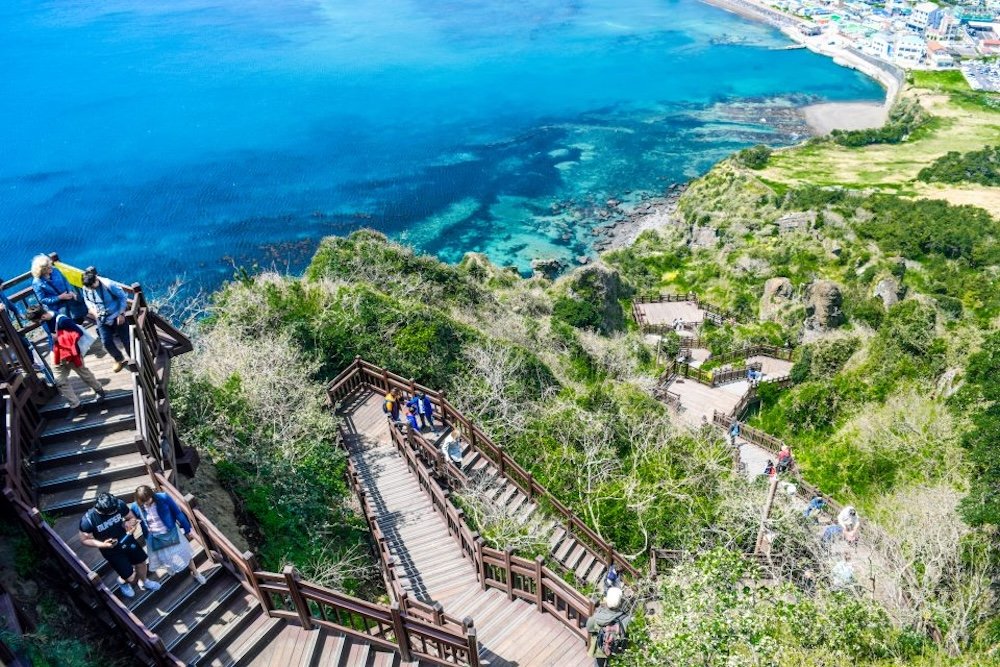
Description of Jeju’s Volcanic Landscapes, Including Hallasan Mountain
The volcanic landscapes of Jeju Island are among its most breathtaking features.
Dominating the scenery is Hallasan Mountain, the highest peak in South Korea, standing at 1,947 meters above sea level.
This majestic mountain is not only a central physical feature of Jeju Island but also a spiritual one, often considered a sacred place by locals.
The mountain’s slopes are dotted with a variety of hiking trails that cater to all levels of experience, offering panoramic views and a chance to walk through well-preserved natural environments.
The Island’s Unique Geological Features: Lava Tubes and Volcanic Craters
Beyond its imposing mountain, Jeju Island is also famous for its extensive network of lava tubes and dramatic volcanic craters.
These geological formations are a direct result of the island’s volcanic origins and are some of the most accessible examples of such phenomena in the world.
The Manjanggul Lava Tube is a highlight, known for its impressive length and the stunning lava column that stands as one of the largest in the world.
Beaches and Waterfalls That Attract Tourists
The natural allure of Jeju Island extends to its pristine beaches and stunning waterfalls.
Hyeopjae and Hamdeok Beach are renowned for their crystal-clear waters and fine white sands, making them perfect for swimming and sunbathing.
Waterfalls like Cheonjiyeon and Jeongbang, not only offer spectacular views but also provide refreshing swimming spots during the warmer months.
Each of these natural attractions draws visitors looking for both relaxation and adventure, contributing significantly to the island’s tourist appeal.
Importance of These Natural Sites to the Island’s Popularity
The natural attractions of Jeju Island are central to its identity as a tourist destination.
The island’s unique topography and accessible natural beauty are key factors in its appeal, attracting eco-tourists, adventure seekers, and nature lovers from around the globe.
These sites are not just visually stunning; they are an integral part of what makes Jeju Island a unique destination, differentiating it from other islands around the world.
The ongoing conservation efforts to maintain these natural landscapes also emphasize the island’s commitment to sustainable tourism, enhancing its popularity further among conscientious travelers.
Recreational Activities
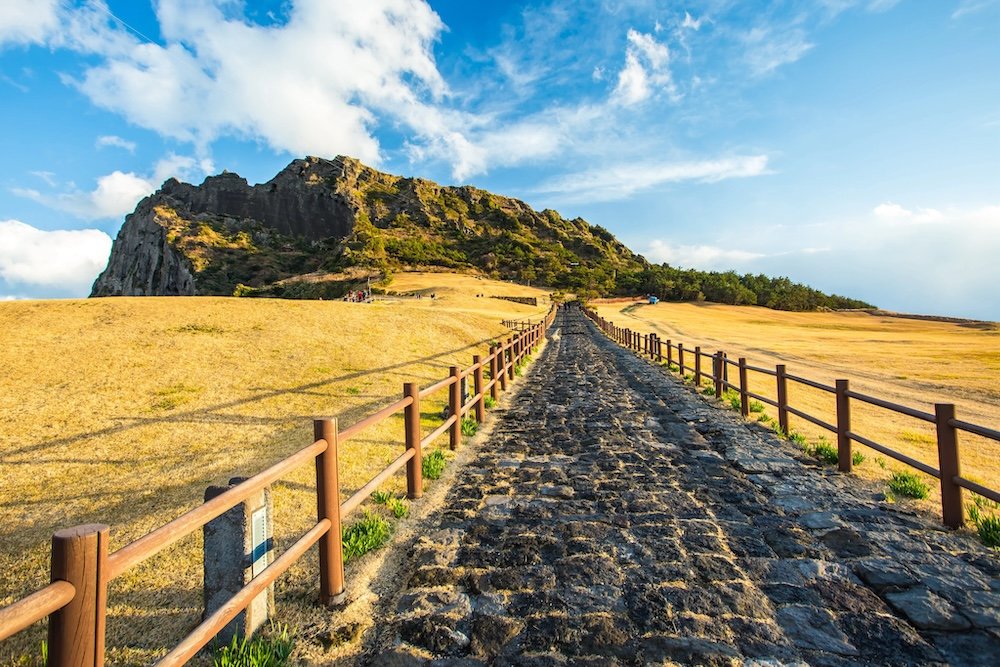
Hiking, Including Popular Trails and Seasonal Tips
Hiking is one of the most popular activities on Jeju Island, with the island’s varied terrain offering everything from easy walks to challenging treks.
The trails around Hallasan Mountain are particularly renowned, offering routes that vary in difficulty and are accessible year-round, though the spring and fall seasons are ideal due to milder weather and the beautiful change in foliage.
The Olle Trail is another favorite, winding through some of Jeju Island’s most picturesque landscapes, including coastal paths, small villages, and volcanic fields.
Water Sports and Activities (Surfing, Diving, Fishing)
The clear waters surrounding Jeju Island make it a perfect destination for water sports enthusiasts.
Surfing is popular at beaches like Jungmun and Hyeopjae, where waves cater to a range of skills from beginner to advanced.
Diving is another sought-after activity, with the island’s underwater world being as vibrant and diverse as its terrestrial environments.
The waters around Seongsan Ilchulbong are particularly famous for their visibility and biodiversity, offering divers the chance to explore underwater lava formations and a variety of marine life.
For those interested in fishing, the island offers abundant opportunities, from deep-sea fishing trips to quiet afternoons by the shore.
Adventure Sports, Such as Paragliding and Horseback Riding
For the adrenaline seekers, Jeju Island provides thrilling adventure sports options.
Paragliding over the island offers unparalleled views of the stunning natural landscapes, particularly the dramatic coastline and lush greenery that characterize the island.
Horseback riding is also a unique way to experience Jeju Island, with several trails designed specifically for equestrian activities, allowing visitors to ride through scenic fields and along mountain paths, fully immersing them in the tranquility of the island’s natural beauty.
Cultural Experiences
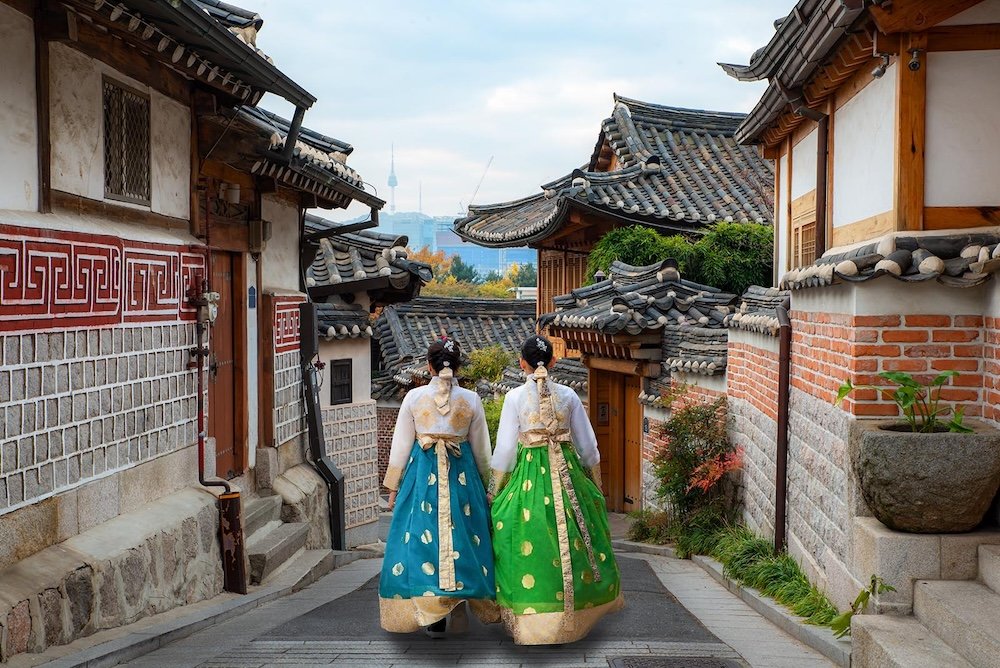
Local Festivals and Events That Highlight Jeju’s Culture
Jeju Island is a vibrant hub of cultural festivities that celebrate its unique heritage and the rhythms of nature.
One of the most iconic events is the Jeju Fire Festival (Jeongwol Daeboreum Fire Festival), which marks the beginning of spring and involves lighting fire to old grass to ensure a healthy harvest.
Another significant event is the Jeju Haenyeo Festival, which honors the island’s female divers with exhibitions, performances, and diving demonstrations.
These festivals not only offer a glimpse into the traditional way of life on Jeju Island but also allow visitors to participate in and appreciate the local culture.
Culinary Experiences: Traditional Dishes and Where to Find Them
The cuisine of Jeju Island is as distinctive as its landscape, heavily influenced by its maritime geography. Seafood is a staple, with dishes like Haemul-tang (seafood stew) and Jeonbok-juk (abalone porridge) being local favorites.
Black pork is another delicacy unique to the island, known for its rich flavor and tenderness.
These culinary delights can be best experienced at local markets such as Dongmun Market, where traditional food stands offer a taste of genuine Jeju flavors in a lively atmosphere.
Art and Craft: Exploring Jeju’s Artistic Side Through Local Crafts and Museums
Jeju Island also boasts a flourishing arts scene, with its history and natural beauty serving as inspiration for countless artisans.
Visitors can explore this artistic side by visiting craft villages like the Jeju Folk Village, where traditional thatched houses and artisanal workshops provide a window into the island’s craft traditions.
The island’s museums, such as the Jeju National Museum and the Jeju Museum of Art, showcase both historical artifacts and contemporary artworks, reflecting the island’s cultural evolution.
Additionally, handcrafted items such as Jeju’s famous stone sculptures and pottery make for unique souvenirs that embody the island’s artistic heritage.
Accommodations and Travel Facilities

Range of Accommodations: From Luxury Resorts to Cozy Guesthouses
Whether you are seeking luxury or simplicity, Jeju Island offers a diverse range of accommodations to suit every taste and budget.
Luxury seekers can find solace in high-end resorts like the Lotte Hotel Jeju and The Shilla Jeju, which provide exquisite services and amenities, including ocean views, spas, and gourmet dining.
For those who prefer a more intimate setting, cozy guesthouses and B&Bs are scattered across the island, offering comfortable lodgings with a personal touch.
Places like the Jeju Hiking Inn and Yeha Guesthouse provide friendly, affordable stays with easy access to local attractions.
Transport Options on and to the Island
Getting to Jeju Island is facilitated by its well-connected Jeju International Airport, which offers flights from various international and domestic locations.
Once on the island, visitors have multiple transport options to explore the vast landscapes.
Renting a car is the most convenient way to navigate the island at your own pace, but for those who prefer not to drive, the local bus system provides comprehensive coverage, connecting all major attractions efficiently. Taxis are readily available and reasonably priced, making them a good option for shorter trips.
Tips for Navigating the Island Effectively
Navigating Jeju Island can be a breeze with a bit of planning.
One key tip is to leverage the island’s excellent GPS and map services to route your travels efficiently.
If opting for public transport, purchasing a T-money card, which can be used on buses and in taxis, will make travel smoother and often cheaper.
For those planning to explore more remote areas, it is advisable to schedule transportation ahead of time, especially during peak tourist seasons when demand can be high.
Lastly, consider touring the island in a circular route to maximize the sights you visit while minimizing backtracking.
Ecotourism and Sustainable Travel
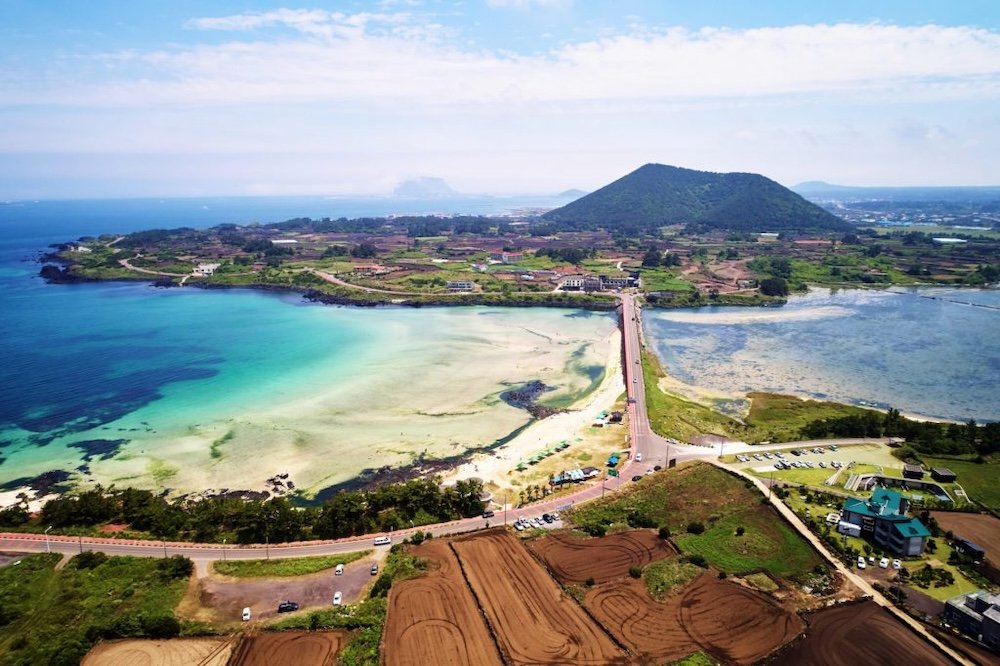
Jeju’s Initiatives in Preserving Its Natural and Cultural Heritage
Jeju Island is deeply committed to preserving its exquisite natural environments and rich cultural heritage.
The island has implemented several conservation programs that focus on maintaining its biodiversity and promoting the sustainability of its unique ecosystems.
For instance, the Jeju Olle Trail, designed to guide tourists along less disruptive paths, helps protect sensitive areas while offering immersive experiences.
Additionally, Jeju Island‘s status as a UNESCO Global Geopark plays a crucial role in its conservation efforts, promoting sustainable tourism and educational initiatives about the island’s geological significance.
Eco-friendly Activities and How Tourists Can Participate
Visitors to Jeju Island have numerous opportunities to engage in eco-friendly activities that support the island’s environmental goals.
Participating in beach clean-ups, choosing eco-certified accommodations, and using electric rental cars are just a few ways tourists can contribute to sustainability.
Additionally, eco-tours offer guided experiences that teach visitors about local flora and fauna, with a portion of the tour proceeds often going towards conservation projects.
These activities not only enhance the visitor experience but also help ensure that the island’s natural beauty can be preserved for future generations.
Importance of Sustainable Tourism in the Popularity of Jeju
Sustainable tourism has been a significant factor in the enduring popularity of Jeju Island.
By prioritizing the health of its environmental and cultural sites, Jeju has maintained its appeal as a destination that offers more than just scenic beauty—it allows visitors to participate in a larger movement towards sustainability.
This commitment to sustainability attracts tourists who are increasingly conscious of their travel impact, and it helps to foster a tourism model that supports both economic growth and environmental preservation.
Seasonal Attractions
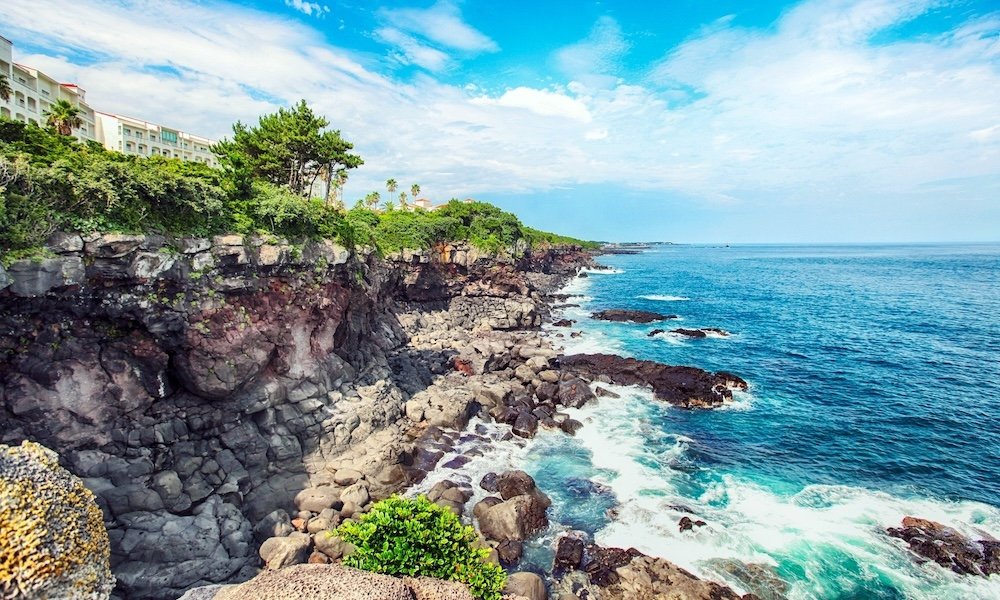
What to See and Do in Jeju During Different Seasons
Jeju Island offers a diverse array of attractions that vary with the seasons, providing unique experiences throughout the year.
- Spring (March to May) is a time of vibrant blossoms, with the Jeju Cherry Blossom Festival being a highlight. The island’s countryside is adorned in pink, offering spectacular sights especially in areas like Jeonnong-ro. Spring is also ideal for hiking, as the weather is mild and the natural scenery is at its most vibrant.
- Summer (June to August) brings warm weather perfect for exploring Jeju’s renowned beaches like Jungmun and Hyeopjae, where one can enjoy sunbathing, swimming, and water sports. This season also sees the vibrant Jeju Ocean Festival, celebrating maritime culture and sports.
- Fall (September to November) is perhaps the most scenic season, when the island’s foliage turns dramatic shades of orange and red. It’s a great time for trekking through Hallasan National Park or cycling along the coastal paths.
- Winter (December to February) on Jeju Island is milder than on the mainland, allowing for comfortable exploration. Winter illuminations and the Jeju Winter Festival make the island festive, and it’s an excellent season for enjoying hot springs and the scenic snow-dusted landscapes.
Special Events and Natural Phenomena Unique to Each Season
Each season on Jeju Island not only changes the landscape but also brings with it unique natural phenomena and cultural events:
- Spring witnesses the rapeseed flowers’ blooming, particularly around the areas of Seongsan Ilchulbong, creating expansive yellow fields that are a must-see.
- Summer offers the chance to witness haenyeo performances, where female divers demonstrate their traditional diving skills in the warmer waters.
- Fall is renowned for its wind festivals, including the Jeju Wind Festival which celebrates the cultural and natural significance of the island’s windy climate with kite flying competitions and wind-related art installations.
- Winter is special for its camellia blooms, which decorate the island in vivid reds and pinks, and for the rare opportunity to see snow-capped Hallasan, a truly majestic sight.
Conclusion
Throughout this article, we have explored the myriad reasons why Jeju Island stands as South Korea’s most popular island destination.
From its rich historical and cultural significance, evident in the traditions of the Haenyeo and vibrant local festivals, to its breathtaking natural landscapes, including volcanic craters, lush mountains, and serene beaches, Jeju Island offers a unique blend of attractions that cater to every type of traveler.
The array of recreational activities, from hiking on scenic trails to diving in crystal-clear waters, ensures that there is never a dull moment for visitors.
Moreover, Jeju Island‘s commitment to sustainable tourism practices highlights its role as a leader in preserving the delicate balance between welcoming tourists and maintaining the environmental and cultural integrity that makes it so special.
This dedication not only enhances the visitor experience but also ensures that the island’s treasures will continue to delight for generations to come.
As you plan your visit to Jeju Island, consider how you can contribute to the preservation of this unique destination.
Engage with the local culture respectfully, participate in eco-friendly activities, and choose services that support sustainable practices.
By doing so, you help ensure that Jeju Island remains a beloved and beautiful escape for all who seek its shores.
In conclusion, whether you are drawn by the allure of its natural wonders, the depth of its cultural heritage, or the thrill of its recreational offerings, Jeju Island promises an unforgettable experience that will resonate with you long after you leave.
It is a place where every visit enriches the soul and where the beauty of nature and human creativity coexist in harmony.
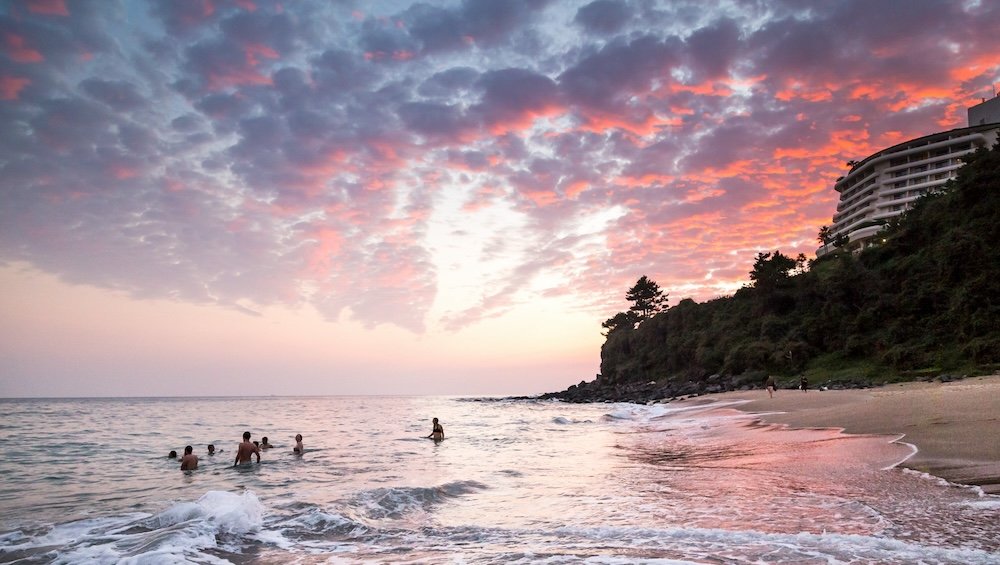
FAQ’s About Jeju Island in South Korea:
Why is Jeju Island so famous?
Jeju Island is famous for its stunning natural landscapes, unique cultural experiences, and vibrant local traditions.
It boasts a range of attractions from Hallasan Mountain, a dormant volcano and the highest point in South Korea, to beautiful beaches and expansive lava tube systems.
The island is also known for its distinctive culture, including the Haenyeo (female divers) and a variety of local festivals that celebrate its history and traditions.
Why is Jeju Island one of the 7 Wonders?
Jeju Island was named one of the New7Wonders of Nature in 2011.
This distinction was awarded due to its exceptional natural beauty and significant geological value, including its volcanic features like craters, caves, and lava tubes, alongside its rich biodiversity both on land and in the surrounding seas.
How many days in Jeju is enough?
Generally, spending 3 to 5 days on Jeju Island is enough to explore the major attractions without feeling rushed.
This duration allows visitors to hike Hallasan Mountain, visit major volcanic sites and beaches, and experience some cultural activities.
Those interested in a more relaxed pace or wishing to delve deeper into the island’s offerings might consider extending their stay to a week.
What is the best month to visit Jeju Island?
The best months to visit Jeju Island are during the spring (April to June) and fall (September to November).
During these months, the weather is mild, and the natural scenery is at its peak with spring blossoms or autumnal leaves.
These seasons also avoid the peak tourist crowds and the more extreme weather conditions of summer and winter.
Is Jeju Island Expensive?
The cost of visiting Jeju Island can vary significantly based on travel style.
While there are options for luxury accommodations and dining that can be quite expensive, the island also offers a range of budget-friendly choices, including affordable guesthouses, local eateries, and public transportation. Overall, Jeju can accommodate a wide range of budgets.
Is it expensive to go to Jeju Island?
Traveling to Jeju Island can be relatively inexpensive, especially if flying from within Korea, where frequent domestic flights offer competitive prices.
Costs will vary depending on the origin of travel and the time of year. International travelers might find the cost higher due to the additional international leg of the journey.
Can you get around Jeju Island without a car?
Yes, it is possible to get around Jeju Island without a car.
The island has a comprehensive bus system that connects most major attractions and towns.
However, renting a car can provide more flexibility and convenience, especially for accessing more remote areas or for those with limited time.
Is Jeju Island English friendly?
Jeju Island is relatively English-friendly, especially in tourist-centric areas such as hotels, major attractions, and transportation hubs. Signage in these areas often includes English.
However, in less touristy areas, English prevalence diminishes, and having a basic grasp of Korean phrases or a translation app might be helpful.
Can I swim in Jeju Island?
Yes, swimming is a popular activity on Jeju Island, with numerous beautiful beaches that are safe for swimming during the warmer months (late spring to early autumn).
Beaches like Hyeopjae, Jungmun, and Hamdeok are well-known for their clear waters and scenic backdrops.
Do I need a visa to Jeju Island?
Visitors to Jeju Island from most countries do not need a visa if they are visiting only Jeju and staying for less than 30 days, thanks to a special visa exemption policy aimed at boosting tourism.
However, this exemption does not apply if visitors plan to travel to other parts of South Korea, for which a visa might be required depending on the traveler’s nationality. Always check the latest visa requirements before traveling.





